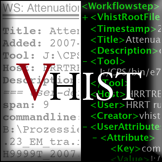About
The VHIST project defines a file format designed to document
data-processing workflows. VHIST allows you to store all information
about individual steps of your workflow within one file – the complete
history of your processed data (including all branches in the workflow) is
stored at one single location. VHIST has several distinct features:
- PDF Compatible
The
VHISTfile format is compatible to the PDF file format. Therefore, you can view yourVHISTfiles on any platform that ships a PDF browser - your Windows PC, your Mac laptop, your Unix workstation or even your smartphone or tablet. Most PDF browsers support extracting embedded data stored in aVHISTfile.Sending a
VHISTfile to somebody who is not familiar withVHISTis trouble-free. Simply rename the file extension to .pdf and the person will immidiately know what to do with the file. There is no need to download and install additional software if you just want to view oneVHISTfile. - Machine Readable
In addition to the human-readable PDF representation,
VHISTfiles contain all user-supplied information as structured XML data. It is easy to automatically extract this information from aVHISTfile for automated processing or validation. - Can Store Arbitrary Binary Data with Meta-Data
VHISTallows you to store any kind of data or meta-data, either in the form of key-value pairs or as files embedded inside theVHISTfile. You can embed any type of file in aVHISTfile: raw data, images, log files, configuration files of even otherVHISTfiles. The choice of format is only up to you and your needs.You can store files in compressed form to reduce the required space. If you do not want to embed a file into a
VHISTdocument for whatever reasons, you can still letVHISTrecord meta-information about the file (such as location, filesize, MD5 fingerprint and date of last modification). - Incremental History
You can create
VHISTfiles incrementally. If your workflow is composed of three individual steps, you can create a newVHISTdocument for the first workflow step and extend it twice for the following two steps.Each workflow step will be embedded as an individual section within one
VHISTdocument. New sections are strictly appended to the end of the document. Old data is never modified and there is no risk of accidentially altering or deleting preceeding steps. - Easy to Integrate into Existing Workflows
VHISTfiles are created using the command line programvhistadd. You can specify arguments, options and files either on the command line or as platform independent "argument files". If your workflow allows you to add command line calls in between individual workflow steps, you can integrateVHISTinto your workflow.We also provide libraries to easily create
VHISTfiles from within C++, Python or Matlab programs without the need to directly use the command line. More interfaces for other programming languages will follow in the future.Last but not least, we provide a commandline tool
vhistifythat automates the creation ofVHISTfiles for a wide range of applications and scripts . Documenting the Python call$ python myscript.py
can be as simple as
$ vhistify --plugins=python python myscript.py
- Self-Describing and Simple to Parse
VHISTfiles contain special markers, which can be used to extract embedded files and meta-information without the need to know anything about the PDF file format. A small Python program to extract all data from aVHISTfile is included at the beginning of eachVHISTfile and can be extracted using any plain text editor. - Validation at Several Levels
VHISTfiles contain checksums for each embedded file and each section. You can verify the validity of aVHISTfile and the embedded files with these checksums. Each file and each section is independant of all other files and sections - one corrupt section does not invalidate theVHISTfile as a whole. - Cross-Platform
You can view
VHISTfiles on all platforms that provide a PDF browser. Moreover, our tools for creating, finding, viewing and validatingVHISTfiles are available on all major desktop platform (Windows, Mac OS X and Linux). - Open Source
The
VHISTdocumentation as well as the reference implementation are subject to the GNU Lesser General Public License (Version 2.1). You can use and distributeVHISTfree of charge. Since the source code of the reference implementation is freely available, you can adjust the tools to your liking, integrateVHISTinto your own programs or even contribute back bugfixes or new features to theVHISTproject. - Installers for Different Platforms


